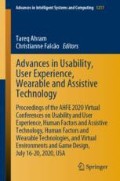Abstract
The purpose of this study was to investigate the effects of the interaction mode on users’ wayfinding performance. Both the dynamic peephole (DP) and static peephole (SP) interaction modes were examined. Sixty users were divided into two groups, where users in one group had previous experiences of mobile wayfinding (i.e., experienced users) while those in the other group did not (i.e., inexperienced users). The experiment was a 2 × 2 within-subjects design. All of the participants were invited to complete four wayfinding tasks, and the system usability scale (SUS) questionnaire was also adopted. The results show that adopting a dynamic peephole is superior to a static peephole for perceptual wayfinding tasks. Interaction mode and user experience did not significantly affect wayfinding performance in general. Moreover, dynamic peephole gained a higher SUS score.
Access this chapter
Tax calculation will be finalised at checkout
Purchases are for personal use only
References
Fitzmaurice, G.W.: Situated information spaces and spatially aware palmtop computers. Commun. ACM 36, 39–49 (1993)
Yee, K.-P.: Peephole displays: pen interaction on spatially aware handheld computers, pp. 1–8. ACM (2003)
Pahud, M., Hinckley, K., Iqbal, S., Sellen, A., Buxton, B.: Toward compound navigation tasks on mobiles via spatial manipulation. In: Proceedings of the 15th International Conference on Human-Computer Interaction with Mobile Devices and Services - MobileHCI 2013, Munich, Germany, pp. 113–122. ACM (2013)
Kaufmann, B., Ahlström, D.: Studying spatial memory and map navigation performance on projector phones with peephole interaction. In: Proceedings of the SIGCHI Conference on Human Factors in Computing Systems - CHI 2013, Paris, France, pp. 3173–3176. ACM (2013)
Grubert, J., Pahud, M., Grasset, R., Schmalstieg, D., Seichter, H.: The utility of Magic Lens interfaces on handheld devices for touristic map navigation. Pervasive Mob. Comput. 18, 88–103 (2015)
Morrison, A., Oulasvirta, A., Peltonen, P., Lemmela, S., Jacucci, G., Reitmayr, G., Näsänen, J., Juustila, A.: Like bees around the hive. In: Proceedings of the 27th International Conference on Human Factors in Computing Systems - CHI 2009, Boston, MA, USA, pp. 1889–1898. ACM (2009)
Rädle, R., Jetter, H.-C., Müller, J., Reiterer, H.: Bigger is not always better. In: Proceedings of the 32nd Annual ACM Conference on Human Factors in Computing Systems - CHI 2014, Toronto, Ontario, Canada, pp. 4127–4136. ACM (2014)
Hürst, W., Bilyalov, T.: Dynamic versus static peephole navigation of VR panoramas on handheld devices. In: Proceedings of the 9th International Conference on Mobile and Ubiquitous Multimedia, p. 25. ACM (2010)
Araki, T., Komuro, T.: On-mouse projector: peephole interaction using a mouse with a mobile projector. Pervasive Mob. Comput. 50, 124–136 (2018)
Burigat, S., Chittaro, L.: Navigation in 3D virtual environments: effects of user experience and location-pointing navigation aids. Int. J. Hum. Comput. Stud. 65, 945–958 (2007)
Hölscher, C., Brösamle, M.: Capturing indoor wayfinding strategies and differences in spatial knowledge with space syntax. In: 6th International Space Syntax Symposium, pp. 043.001–043.012 (2007)
Bowman, D.A., Johnson, D.B., Hodges, L.F.: Testbed evaluation of virtual environment interaction techniques. Presence-Teleoperators Virtual Environ. 10, 75–95 (2001)
Mehra, S., Werkhoven, P., Worring, M.: Navigating on handheld displays: dynamic versus static peephole navigation. ACM Trans. Comput. Hum. Interact. (TOCHI) 13, 448–457 (2006)
Author information
Authors and Affiliations
Corresponding author
Editor information
Editors and Affiliations
Rights and permissions
Copyright information
© 2020 The Editor(s) (if applicable) and The Author(s), under exclusive license to Springer Nature Switzerland AG
About this paper
Cite this paper
Li, X., Chen, CH. (2020). The Effect of Peephole Interaction Mode and User Experience on Wayfinding Performance. In: Ahram, T., Falcão, C. (eds) Advances in Usability, User Experience, Wearable and Assistive Technology. AHFE 2020. Advances in Intelligent Systems and Computing, vol 1217. Springer, Cham. https://doi.org/10.1007/978-3-030-51828-8_5
Download citation
DOI: https://doi.org/10.1007/978-3-030-51828-8_5
Published:
Publisher Name: Springer, Cham
Print ISBN: 978-3-030-51827-1
Online ISBN: 978-3-030-51828-8
eBook Packages: EngineeringEngineering (R0)

